We're an affiliate
We hope you love the products we recommend! Just so you know, we may collect a share of sales or other compensation from the links on this page at no additional cost to you. Thank you if you use our links, we really appreciate it!
We’ve all seen it, our dog scratching their ears using their paws, and our first thought is, “Aww, that’s so adorable!” But what if it gets excessive, to the point of shedding and rashes? Let’s take a look and answer your question, “Why is my dog itching so much?”
We do not want to see our furbaby uncomfortable every time they are scratching uncontrollably, and as their pet parent, soothing their itchy skin is always our top priority.
There are several reasons why dogs get itchy skin, and through proper diagnosis from your veterinarian, you will be able to get rid of this intolerable habit in no time.

When treating the itchiness effectively, it is crucial to treat the underlying cause. Typically, pet parents suspect fleas as the problem, but there are many more possible causes of itchiness, which we will tackle along with this article.
What is Pruritus?
Pruritus is the medical term for the itchiness feeling in cats and dogs. This condition is usually irritating to the point of licking, rubbing, or biting off their skin.
It is typically linked to redness and inflamed areas of the skin that may lead to a skin condition called pyoderma, or any skin disease that is accompanied by pus.
Pruritus is a clinical indicator of inflamed skin and is not a diagnosis or a specific disease. It is common in skin disorders, parasites, allergies, tick and flea infestations, and various other conditions.
Sometimes, pruritus is caused by a severe underlying medical condition, so it is vital to have your dog diagnosed by a veterinarian if you see these symptoms:
- Flea or tick infestation
- Other parasites such as scabies or lice
- Seasonal allergies
- Food allergies
- Dry skin
- Dermatitis
- Mange
- Bacterial infections
- Self-inflicted wounds due to excessive scratching
What Causes My Dog’s Itchiness?
When a dog’s skin is itchy, veterinarians generally categorize the causes of parasites, allergies, and poor nutrition.
But there are certain scenarios where endocrine diseases, cancer, drug reaction, or cancer may have caused it. Sometimes more than one category may be contributing to the itchiness.
We have listed down for you some factors as well as recommendations on things you can do to relieve the itchiness. Before trying these reliefs, ask approval from your veterinarian to get the best results:
1. Nutrient Deficiency
As pet parents, we want anything but the best for our dogs, and that includes proper nutrition. There are bountiful dog foods to choose from, and sometimes we get overwhelmed. There are wet, dry, canned, raw foods, and other varieties to choose from.
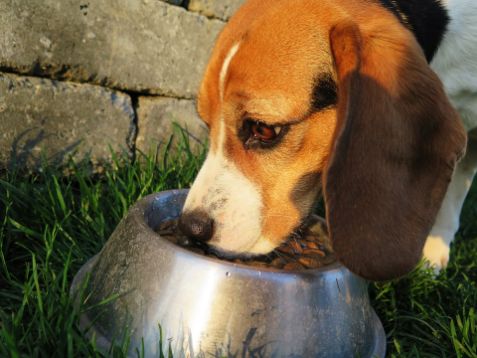
Diets consisting of low-nutrient ingredients can usually cause itching to our dogs. Good nutrition is equal to a strong foundation of health, and the lack of it can result in many medical issues.
There are certain ingredients in dog food that have little to no nutritional value, such as corn and by-products, and this usually causes poor nutrition.
To get the best out of your dog’s food, learn how to read the labels correctly, and distinguish which food is suitable for a healthy dog.
Learn To Read Your Dog’s Food Label
The food label and ingredients list are the best tool to use when making a choice, but can often be challenging to understand. Here’s how to read the food label properly.
- Ingredients List
Like manufactured food for humans, pet food companies list ingredients according to their weight, starting with the heaviest.
However, if the first ingredient in your dog food is some type of meat, take note that it is not 100% made out of protein since any meat is still composed of 75% water.
When you see the word “by-product,” don’t get alarmed that it includes animals’ intestines, livers, stomach, blood, brains, and bone.
These ingredients may seem gross, but dogs love this and are rich in vitamins and minerals.
- Guaranteed Analysis
National food authorities from most countries require dog food manufacturing companies to show the minimum amount of nutrients their pet food contains.
It can be seen through the Guaranteed Analysis section of the food label. This lists down the percentage of crude protein, crude fat, crude fiber, and water per serving.
- Nutritional Adequacy Statement
This section ensures that when their dog food is fed to the dog solely as an everyday source of nutrition, it meets the pets’ nutritional requirements.
Here’s an example of a food label from a popular dog food brand.
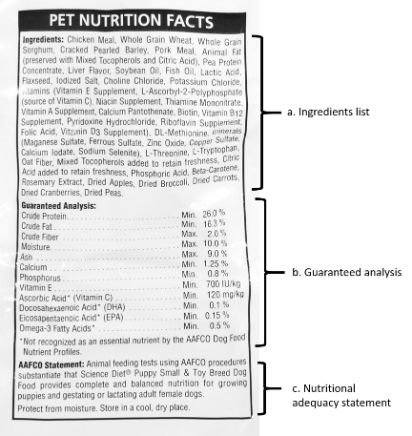
2. Skin Infection
Skin infection is typical among pets, and the usual causes are ringworm, yeast, and bacterial infection. Reach out to your vet to get a proper diagnosis of your dog’s skin.
3. Fleas
Fleas are known to the pet parent community as nasty bugs that can infect humans. Contrary to this common belief, dog fleas cannot survive on human skin. While it can jump over to humans and bite, it cannot survive on us because of two reasons:
- They only consume dog blood.
- Humans are not hairy enough to provide hiding coverage or the warm environment they seek in a host.
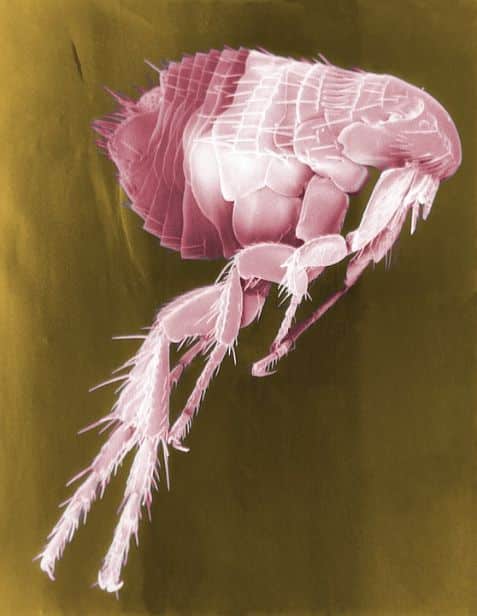
Dog fleas bring inconvenience to our dogs and should be eradicated as soon as possible. Bites from fleas are itchy, but many dogs develop a particular allergy to them. Hair loss and rashes at the base of the spine and tail are the most common indicators for fleas.
Flea allergy dermatitis or FAD is the consequence if your dog gets an allergic reaction from a flea’s saliva. FAD can last for a few weeks, so immediate medical action is a priority!
For an easy home remedy, try using coconut oil. The fat in coconut oil will coat the fleas’ legs and bodies, limiting their mobility and eventually suffocating them.
To do this home-ready, rub the coconut oil on your palms to make it thinner and spread it throughout your dog’s coat, working it down to the skin.
Any pests living in their fur will jump right out due to the repellent nature of lauric acid found in coconut oil. To avoid further infestation inside your house, it is best to do this remedy in your yard.
4. Lice
We have dreaded lice since we were kids, and now as pet parents, we should be alert for dog lice, too. Lice are a rare cause of itching in pets, and they are highly species-specific, which means dogs cannot get lice from cats and vice versa, including human lice.
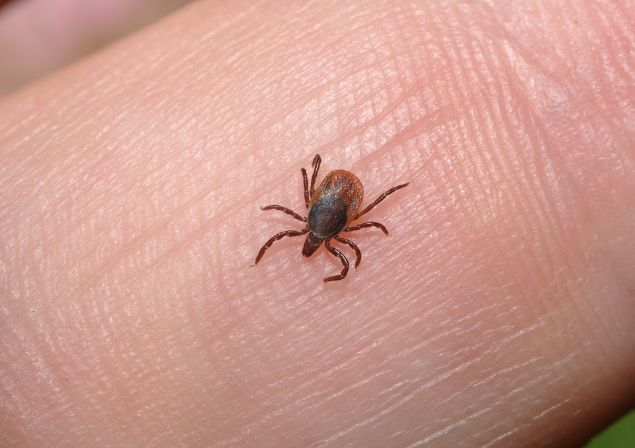
Don’t worry, lice don’t jump from your dog’s fur, unlike fleas. It is easier to prevent lice through good hygiene and consistent grooming.
5. Mites
Half a dozen mites species can infest pets, and the severity can range from mild-mannered Demodex that invades skin to the highly contagious and severely itchy sarcoptic mange.

Your vet diagnoses mites by examining skin scrapings. Keep in mind that negative results do not guarantee that your pet is free from mites because certain species, particularly sarcoptic mange, burrow deep in the skin, making them harder to find.

Most pet owners recommend applying plain, unsweetened yogurt to the affected area to treat mites the all-natural way.
Yogurt’s creamy and thick texture suffocates most of the mites on their skin, and as a bonus, the milk properties in it helps in moisturizing the skin, plus the probiotics it has can eliminate the fungi infesting on your dog’s skin.
6. Airborne Allergies
Most allergens causing humans to have an allergic reaction are also the same triggers that give our pet’s allergies, including dust, grasses, and pollen. While human allergies often exhibit sneezing and watery eyes, dogs’ responses involve dermatitis and skin inflammation that causes them to itch uncontrollably.
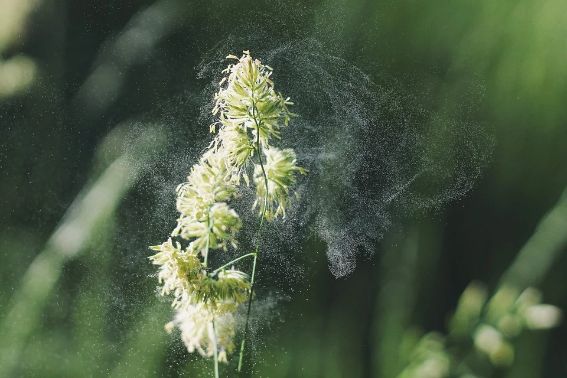
Blood and skin tests are done to diagnose, which triggers the allergy. Fortunately, due to modern technology and research, veterinarians and experts have created numerous allergy medications for dogs.
7. Food Allergies
Although food allergies are more prominent in cats than dogs, it is still a factor that can contribute to your dog’s itchiness.
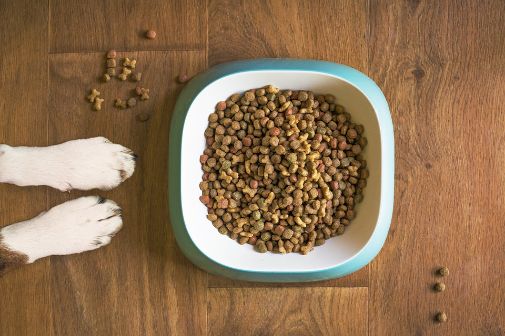
Food allergies can be resolved by observing which ingredient is giving them the reaction. To do this, feed your dog with a specific ingredient one at a time and see which one gives them an allergic reaction. Once determined, it is now easy to avoid any allergic reaction by eliminating this particular food item.
8. Dog Breed
Some dog breeds are more prone to sensitive skin, among others. Dogs with multiple skin folds, especially around the muzzle (such as Bulldogs and Shar Peis), floppy ears (such as Spaniels and Retrievers), or internally hairy ears (such as Poodles) are often itchy because of yeast or bacterial infections in those warm, moist environments.

Certain dog breeds with a single-coat layer are less prone to itching and shedding, making them perfect for pet parents who want low-maintenance furbabies. Find out which breeds they are in our previous article.
9. Vaccination Side Effects
Dogs can exhibit dermatitis and itching after getting a vaccination. A known all-natural remedy is by applying the Thuja plant, which can be helpful for pets that may have vaccine-related itchiness.

10. Hormonal Imbalance
Numerous glandular imbalances may cause skin problems and can result in itching in some pets. Glands within the skin may not function correctly and cause skin itching, discoloration, and discharge.
Most skin problems that contribute to itching occur when certain glands in the skin malfunction. Here are some common medical conditions which can cause itchiness to your furbaby:
- Alopecia X
Alopecia X, also known as Black Skin Disease, is caused by the imbalance of sex hormones that can result in shedding and itching. The ineffective production of melanin is also involved, causing the skin to darken after some time. This disease is rare and can be treated through hormonal intake.
- Cushing’s Disease
When your dog’s adrenal glands overproduce cortisol, it can result in Cushing’s Disease, which can easily be cured by your vet through hormone therapy.
- Addison’s Disease (hypoadrenocorticism)
Unlike Cushing’s, Addison’s disease is where the adrenal glands produce fewer corticosteroid hormones that a dog’s body needs. When it comes to treatment, it also goes the same with Cushing’s, through the help of your veterinarian and administration of hormone treatment.
- Hypothyroidism
If your dog’s thyroid gland fails to produce enough thyroxine that the body requires, it may lead to itchiness. Medication can be prescribed by your vet that will help the dog’s thyroid to produce more thyroxine.
When Should You Call A Vet?
Fortunately, occasional and mild itching is not a telltale sign of severe health conditions, but if your furbaby starts to develop other symptoms, such as loss of appetite, restlessness, or anxiety, or its itchiness has become severe that it breaks its skin when it scratches, call your vet immediately.

It’s vital to determine and give treatment to the underlying cause of the itchiness to avoid worsening the infections of the skin.
Further excessive scratching may cause the wound to open up, which is extremely painful. Depending on the cause, your veterinarian may suggest a prescription medication, over-the-counter meds, or bathing your pet in medicated products.
How to Treat A Dog’s Itchy Skin At Home?
When it comes to medicating your dog’s itchiness, an all-natural remedy is always better than mass-produced chemicals that may give side effects to your furbaby.
There are a lot of home remedies for dog itching skin that can be done using items from your pantry. Keep in mind to consult your vet before trying these home remedies to get their second opinion.
1. Colloidal Oatmeal Baths
A colloidal oatmeal bath can help in soothing your dog’s itchy skin by reducing the inflammation and washing away the allergens such as dust and pollen that got trapped in the fur.
It is done by grinding oatmeal in a blender or food processor until it is fine, then boiling it in water to bring out the soothing properties.

You can purchase pre-made colloidal oatmeal from your pet store or make your own at home by grinding plain, sugar-free oatmeal into a fine powder yourself. An oatmeal bath can aid in relieving your dog’s rashes, swellness, and itchiness. Not only that, the fine texture helps in exfoliating dead skin cells from their skin.
Oatmeal is nature’s anti-inflammatory remedy that can be used to protect the skin. As a yummy bonus, oatmeal is edible, so it is nothing to worry about if your furbaby gets a taste of their bath remedy.
How To Give Your Furbaby Oatmeal Bath at Home?
You will need the following:
- Blender or food processor
- Plain oatmeal
- 1 cup of oatmeal for medium to large dogs; 1/2 cup for smaller dogs
- Room temperature water
- A bathtub or a basin big enough for your dog to fit in
Now that you have the needed ingredients, here’s how to make the perfect oatmeal bath to relieve your dog’s itchiness away.
1. Grind the oatmeal in the food processor or blender until they are very fine, almost like powder.
2. Stir a tablespoon of the fine oats into a glass of warm water and check to see if it absorbs it.
3. If the water is quickly absorbed by the oat powder and the liquid becomes “milky” with a smooth feel, the oats are fine enough to be used.
4. If the liquid did not turn milky, process the oats more for a finer texture. Test the oats in the water again until it combines with the water and forms a milky feel.
Now, for the relaxing part, you are ready to give your dog a soothing oatmeal bath!
1. Pour the fine oat powder into a tub or basin with warm water and stir evenly. Most dogs can tolerate the water to at least their belly.
2. Put your pup in the tub.
3. Using a cup, pour the solution slowly over their body. You can rub some of the oatmeal directly on any particularly affected areas.
4. Gently rub the oatmeal bath to your dog’s fur for about 10 minutes, then set an additional 10 minutes and let them soak in it. Once done, rinse the oat residue using warm running water.
5. Dry your dog with a towel.
2. Apple Cider Vinegar
Apple cider vinegar compliments not only your salad but can also be used to treat your dog’s itchy skin as well! It boasts its natural antibacterial properties that can aid in soothing your dog’s severe scratching.

In a spray bottle, create a solution of 50% apple cider vinegar and 50% water, and spray your dog’s affected area with the solution. If their paws are irritated, you can use this mixture as a relaxing “foot spa” by soaking their paws for five minutes.
Be cautious when applying this solution on open wounds, as this can cause painful discomfort and can worsen the issue.
3. Chamomile and Green Tea Soaks
Sometimes, all we need to de-stress and unwind is a delightful book and some hot, freshly brewed chamomile or green tea. And as an awesome bonus, herbal tea can also relieve your dog’s itchiness away!

To create a relaxing tea bath for your furbaby, steep a few tea bags in a bathtub filled with lukewarm water for three to five minutes. Remove the tea bags and have your dog relaxed while submerged in the bath for five minutes.
4. Aloe Vera
Known as nature’s ointment, aloe vera has lots of medical properties. If you’ve ever had a sunburn, your mom would have probably recommended applying aloe vera on your sore skin which surprisingly also applies to our dog’s skin.

Most drugstores have 100% all-natural aloe vera that is readily available, or you can also get fresh aloe vera from your garden or your friend if they happen to have one in their yard.
5. Baking Soda
Baking soda does not only help in rising your bread dough, it also has medical properties! Combining it with water and making it into a thick paste, baking soda can help in relieving itchiness, and reducing inflammation.

In a bowl, mix 50% baking soda and 50% water until a paste is formed. Apply this paste on your dog’s fur and skin for about 20 minutes while gently rubbing it. You can also add some organic and pure coconut oil to the mixture for added moisturizing properties.
6. Fish and Sweet Potato Diet
Altering your dog’s diet can help eliminate their itchiness, and most vets recommend a diet rich in omega 3 and 6 fatty acids, which can be found in fish.

Replace your dog’s protein with fish since most dogs with food allergies get their allergic reaction from proteins commonly found in their dog foods, such as chicken and beef. Additionally, fish are rich in omega-3 fatty acids, which are helpful in relieving inflammation.
Replacing the carbohydrates with sweet potatoes can eliminate the itching because wheat and gluten allergies are the most common food allergy among dogs.
Itchy skin can come from several reasons such as genes, environment, parasites, and/or diet. These reasons can be treated and are not dangerous, however, it is advisable to always ask your vet and do regular visits and check-ups to make sure your dog is healthy and receive the proper treatments.
Suppose you ever find yourself in a situation wherein your vet is not readily available or looking for natural remedies for a dog’s itchy skin.
In that case, you may want to try some of our suggested solutions listed above. Just be sure to keep your dog’s health and well-being on top of your priority and be ready to visit your vet if the remedy doesn’t work.
We hope that we have answered your question, “Why is my dog itching so much?”. What kind of home remedy did you use? Share it with the pet parent community below!
Laura is the founder of Furs'n'Paws. She is a also a pet writer and expert with more than 20 years of experience of working with dogs and cats. She developed a very strong love for animals at a young age. Her passion led her to establish a thriving pet sitting and dog walking business in Dubai. As an expert in pet training, behavior, and nutrition, Laura is committed to helping pet owners and pet lovers by offering high-quality information on a wide range of topics.



No responses yet